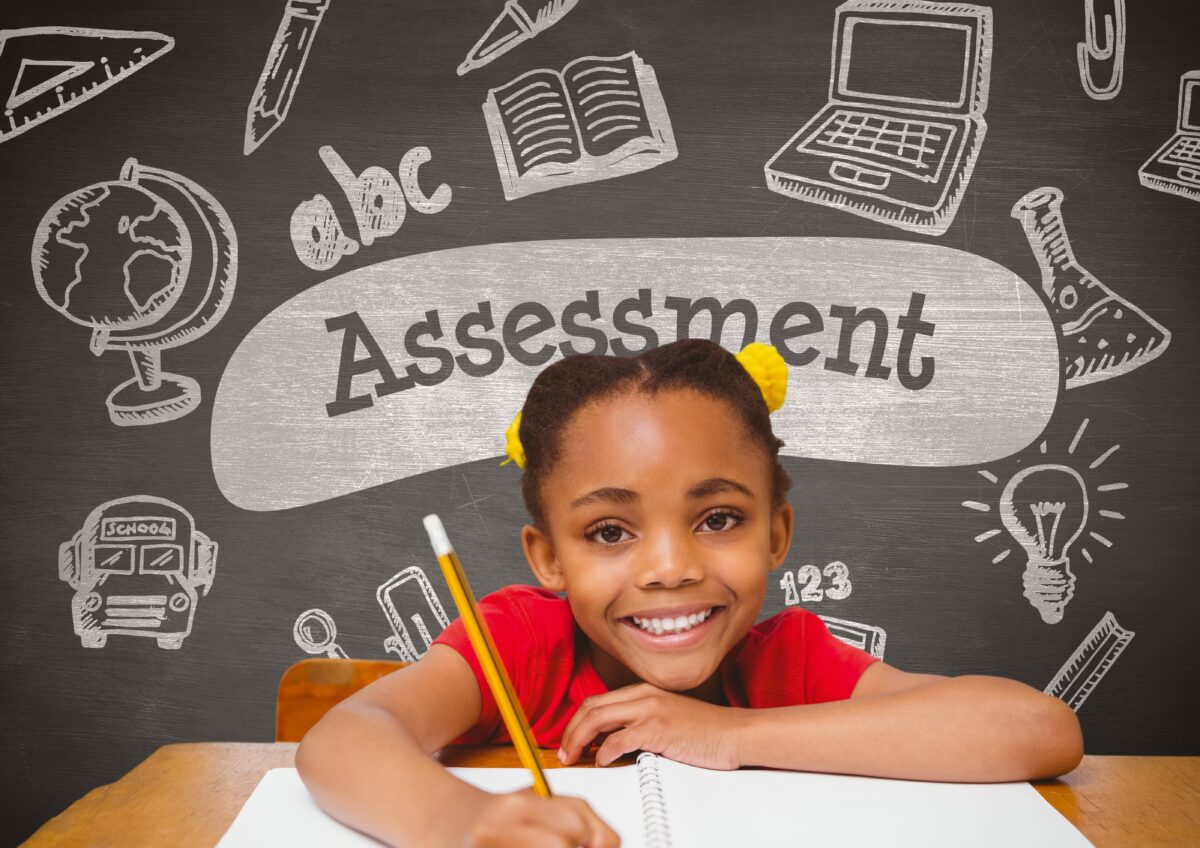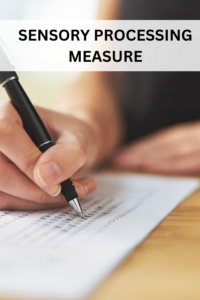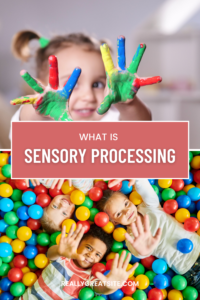
Everything You Need to Know About the Sensory Processing Measure And How it Can Help Your Child
Parenting a child with sensory processing difficulties can be both a challenging and rewarding journey. Understanding your child’s unique sensory needs is crucial for providing the right support and fostering their overall development.
Occupational therapists specialize in working with children with sensory processing difficulties. Occupational therapists use the Sensory Processing Measure, a valuable tool that assesses any sensory processing difficulty that your child may have.
In this comprehensive guide, we’ll delve into what the Sensory Processing Measure is, how it is used by occupational therapists, and how it can empower you to better advocate for your child.

Hi! My name is Marra and I’m a mama and a pediatric occupational therapist who has years of experience working with children with sensory processing and helping their parents navigate the ups and downs of child development.
I loved being a support person for parents learning about sensory processing, and their child’s individual sensory needs.
I’ve used the Sensory Processing Measure many times to assess a child’s sensory processing difficulties. The results of the assessment would guide me in collaborating with their parents to develop an intervention plan.
This post is all about the Sensory Processing Measure, what it is, and how it is used by occupational therapists to help them identify sensory needs and develop an intervention plan to serve that child and their family.
What is Sensory Processing?
Before we explore the Sensory Processing Measure, let’s grasp a better understanding of what sensory processing is. Our sensory system plays a pivotal role in how we interpret and respond to the world around us.
For children with sensory processing difficulties, these everyday sensations might be overwhelming or understimulating, affecting their ability to engage in daily activities.
Sensory processing is our ability to take in information from our environment, filter through what we need to attend to, understand it, and choose an appropriate response to that sensory input.
We have 8 sensory systems through which we receive sensory input from our environment. We have the more well-known 5 senses: what we see, hear, smell, taste, and touch.
We also have 3 additional sensory systems that are less well known, including our vestibular, proprioceptive, and interoception sensory systems.
Our vestibular sense is our sense of gravity and our body’s response to gravity. Our proprioceptive sense is our sense of deep pressure and body awareness. Interoception is the sense of how our body is feeling.
If you’d like to learn more about sensory processing, check out the blog linked blow.

Understanding Sensory Processing Difficulties in CHILDREN
Identifying sensory processing difficulties in children involves recognizing patterns of behavior and reactions to sensory input. How well are they able to process the input that is coming into their sensory systems?
From hypersensitivity to certain textures to seeking out sensory input, each child’s experience is unique. You might observe challenges in your child’s self-regulation, attention, and social interactions, which can be indicative of sensory processing issues.
Sensory processing difficulties can manifest in various ways:
Hypersensitivity: Overreaction to sensory stimuli, leading to discomfort or avoidance.
- Hyposensitivity: Over responsiveness and sensitivity to sensory input, requiring more intense input for a response.
- Sensory seeking: Actively seeking out sensory experiences to self-regulate.

THe Role of Occupational Therapy
Occupational therapists play a crucial role in supporting children with sensory processing difficulties. Through personalized interventions, therapists aim to help children regulate their responses to sensory input and engage more effectively in daily activities.
The Sensory Processing Measure emerges as a valuable assessment tool for indicating sensory processing difficulties.
Occupational therapy sessions often involve creating a sensory-friendly environment, incorporating activities that address specific sensory needs, and collaborating with parents to develop strategies for home and school.

SensorY Processing Measure
1. Overview of the Sensory Processing Measure
- Definition and purpose of the Sensory Processing Measure.
- Various versions are available for different age groups.
The Sensory Processing Measure also known as the SPM-2 is a standardized assessment tool designed to evaluate a child’s sensory processing abilities in various contexts.
It provides a comprehensive understanding of how a child responds to sensory input and helps identify areas of strength and areas that may require support.
The Sensory Processing Measure has multiple forms for different ages as well as forms for child-report, parent-report, and teacher-report.
What’s great about the Sensory Processing Measure is that it looks at both a child’s emotional response as well as their physical response to sensory input.
Examples of physical response to sensory input include balance, coordination, planning of movements (praxis), and how easy or difficult it is to complete certain tasks.
2. Components of the Sensory Processing Measure:
- Sensory Processing Composite
- Praxis Composite.
- Social Participation Composite.
- Fine Motor and Visual-Motor Integration Composite.
The Sensory Processing Measure comprises different components, each assessing specific aspects of sensory processing.
The Sensory Processing Composite evaluates the overall sensory processing abilities, while the Praxis Composite assesses motor planning and execution.
The Social Participation Composite examines a child’s ability to participate in social activities,
The Fine Motor and Visual-Motor Integration Composite focuses on fine motor skills and visual-motor coordination.
3. Administering the Sensory Processing Measure
- How occupational therapists conduct the assessment.
- Collaboration with parents in gathering information.
The Sensory Processing Measure is typically administered by licensed occupational therapists in a controlled environment.
However, what makes it particularly valuable is the collaboration with parents.
Parents are essential contributors to the assessment process, providing valuable insights into their child’s daily experiences and behaviors.
The Sensory Processing Measure is a parent report and or child report assessment.
This means that in most cases, the parent is the one who fills out the Sensory Processing Measure form, answering a series of questions about their child’s behavior, likes and dislikes, and response to different sensory experiences.
If the child is older the occupational therapist might ask the parent to fill out the Sensory Processing Measure parent form and the child to fill out the child form.
There is also a form for teachers to fill out. Some children have different sensory responses or difficulties in the classroom than at home.
If multiple forms are used, the occupational therapist will compare them to each other, grasping a better understanding of the child’s strengths and opportunities to improve.
4. Interpreting Results:
- Understanding the significance of scores.
- Identifying areas of strength and areas needing support.
Interpreting the results of the Sensory Processing Measures requires an understanding of the scores.
Occupational therapists work closely with parents to explain the meaning of the assessment results, emphasizing areas where a child excels and identifying potential opportunities for growth.
This collaborative approach ensures that interventions are tailored to the child’s unique nee

Empowering Parents
With the insights and understanding gained from the Sensory Processing Measure,, parents become powerful advocates for their children.
This section will explore how understanding the assessment results enables parents to collaborate effectively with occupational therapists, educators, and other professionals involved in their child’s care to help meet their child’s sensory processing needs.
1. Individualized Education Plans (IEPs):
- Navigating the educational system with a focus on sensory needs.
- Collaborating with school professionals to implement accommodations.
Understanding the Sensory Processing Measure results allows parents and occupational therapists to actively participate in the development of Individualized Education Plans (IEPs).
These plans outline specific accommodations and interventions to support a child’s unique sensory needs within the educational setting.
2. Effective Communication:
- Building open communication channels with professionals.
- Advocating for your child’s needs in various settings.
Parents who have a full understanding of their child’s sensory needs are better equipped to communicate effectively with occupational therapists, teachers, caregivers, and other professionals involved in their child’s life.
By sharing the Sensory Processing Measure results and insights, parents can foster a collaborative approach that prioritizes the child’s sensory well-being.

Beyond Assessment
Transitioning from assessment to action is the next step to take. Practical strategies and activities that parents can incorporate into their daily routines to support their child’s sensory needs will benefit both your child and your family.
1. Creating a Sensory-Friendly Home Environment:
- Designing safe spaces that cater to sensory needs.
- Introducing sensory-friendly tools and equipment.
A sensory-friendly home environment is essential for a child’s well-being.
An occupational therapist will help you explore how you can adapt your living spaces to provide comfort and stimulation tailored to your child’s sensory preferences.
2. Incorporating Sensory Activities into Daily Routines:
- Daily routines that promote sensory integration.
- Fun and engaging sensory activities for children.
From morning routines to bedtime rituals, incorporating sensory-friendly activities into daily life contributes to your child’s overall sensory development.
Practical suggestions and examples will be provided for you to integrate these activities seamlessly.

Building a Supportive Network
Navigating the world of sensory processing difficulties can be overwhelming, but you don’t have to do it alone. It’s important to build a supportive network of therapist, family, and friends.
There are so many amazing resources for you and children struggling with sensory processing.
For Occupational Therapists
If you are a new occupational therapist or new to the world of occupational therapy I would strongly encourage you to learn more about the Sensory Processing Measure and how you can incorporate it into your evaluations.
To learn more, check out WPS.
